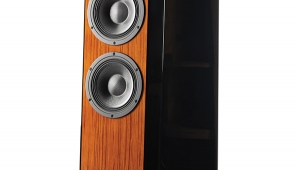| Columns Retired Columns & Blogs |
Snell B minor loudspeaker Measurements
Sidebar 3: Measurements

Fig.1 Snell B minor, electrical impedance (solid) and phase (dashed) with HF control set to maximum (2 ohms/vertical div.).
The B minor's sensitivity, calculated using a noise signal and B-weighting, was exactly to specification at 86dB/W/m. Its impedance magnitude and phase, measured with the Audio Precision System One, are shown in fig.1. The minimum impedance is 4.9 ohms at 210Hz, while the woofer tuning is revealed by the 23 ohm peak at 32Hz. The HF control was set to its maximum for this measurement; reducing the tweeter level increased the impedance in the top octaves. Overall, this Snell should be relatively easy to drive.

Fig.2 Snell B minor, anechoic response on HF axis at 45", averaged across 30° horizontal window and corrected for microphone response, with nearfield midrange response below 400Hz and nearfield woofer response below 1kHz.
Fig.2 is a composite, showing the nearfield response of the side-firing woofer, the nearfield response of one of the midrange units, and the overall response on the tweeter axis at a distance of 45" averaged across a ±15° horizontal window. The B minor is impressively flat in response, with only minor peaks and dips visible in the low treble. (The grille appears to have only a minor effect on the measured response.) As with the Dunlavy Audio Labs SC-IV (also reviewed in this issue), plotting the woofer level with the correct amplitude relationship to the rest of the range is not trivial. The woofer trace shown in fig.2 is my best guesstimate, and appears to show a bit of excess midbass energy before the response starts to roll out. The –6dB point is a very low 25Hz, however.

Fig.3 Snell B minor, effect of HF control at maximum and minimum positions, normalized to response with control at 12 o'clock (5dB/vertical div.).
The fig.2 plot was taken with the HF control set to 12 o'clock. Fig.3 shows the difference in response with it set to its maximum and minimum positions. The entire tweeter range can be boosted by up to 4dB or cut by up to 2dB, giving a sensible 6dB swing overall. The rear tweeter really only covers the top octave, above 10kHz or so.

Fig.4 Snell B minor, horizontal response family at 45", normalized to response on HF axis, from back to front: differences 90° through 5° off-axis on outside edge of baffle; reference response; differences 5° through 90° off-axis on inside (tweeter) edge of baffle.
Vertically, the B minor is relatively uncritical when it comes to the optimal listening axis. As long as you sit with your ears on or between the midrange axes, you will perceive a flat, neutral balance. If you stand so that you can see the top of the cabinet, the sound will become very hollow and sucked-out; so sit, don't stand. Horizontally (fig.4), a couple of peaks develop off-axis, at 3kHz and 5.6kHz, particularly on the outside edge of the baffle, but the rolloff in the treble is otherwise well-controlled. The B minor's balance doesn't change appreciably until the listener is more than 15° to the speaker's side.

Fig.5 Snell B minor, impulse response on HF axis at 45" (5ms time window, 30kHz bandwidth).

Fig.6 Snell B minor, step response on HF axis at 45" (5ms time window, 30kHz bandwidth).

Fig.7 Snell B minor, cumulative spectral-decay plot.
In the time domain, the B minor's impulse response (fig.5) is typical of a design using high-order crossover filters. Compare the Dunlavy SC-IV's for an impulse response which is time-coherent. The step response calculated from the impulse response (fig.6) indicates that the tweeter leads the midrange units by around 1/3ms, with then the slow rise of the woofer lagging by about 3ms. All three drive-units are connected with positive polarity. The waterfall plot (fig.7) shows a basically clean initial decay, but with some residual resonant modes present in the low treble.—John Atkinson
- Log in or register to post comments




































